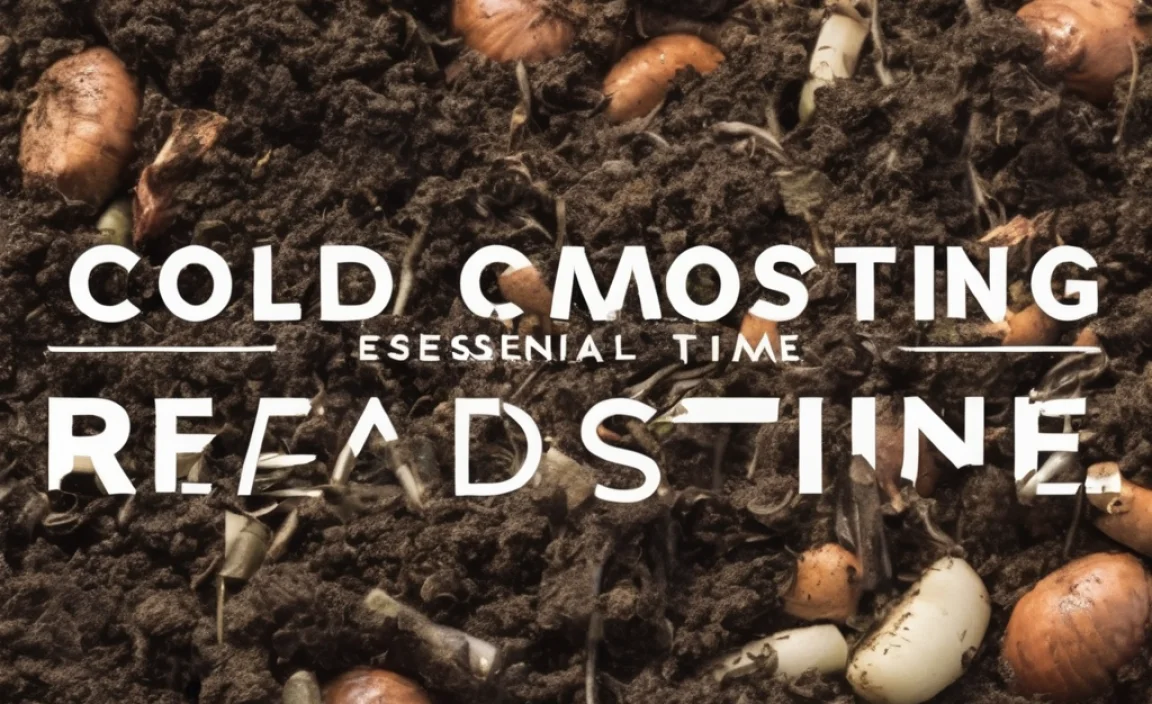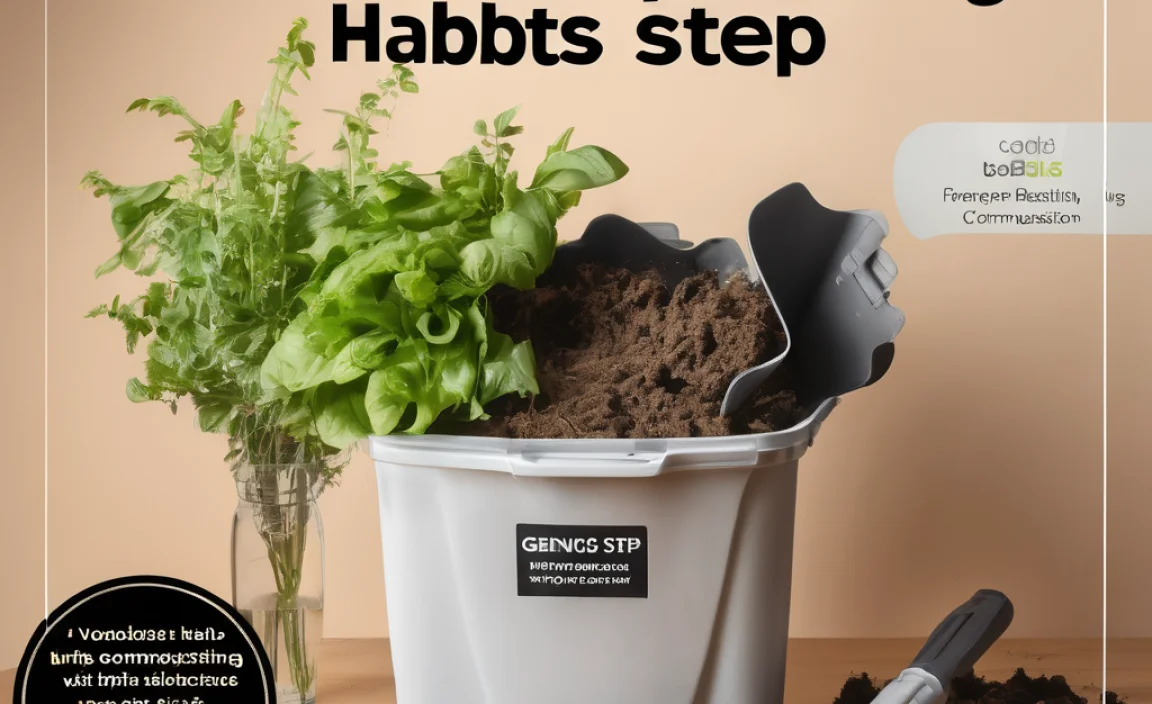Have you ever wondered how composting turns waste into rich soil? Composting is nature’s way of recycling. But did you know that temperature plays a big role in composting? Let’s explore why the right composting temperature is important. This helps break down waste faster and makes better compost. Let’s dive into the warm world of composting!
Key Takeaways
- Ideal composting temperature speeds up waste breakdown.
- Hot composting works faster than cold composting.
- Compost piles need air, water, and heat.
- A thermometer helps track composting temperature.
- Right temperature kills harmful pathogens.
Composting Temperature Basics
Composting is more than just throwing scraps in a pile. The composting temperature must be right for it to work. When composting, the pile heats up as bacteria breaks down organic matter. This process is like a tiny oven in your backyard. The heat helps decompose the materials faster. If the temperature is too low, the process slows down. Too high, and it can dry or kill important bacteria. Keeping the right temperature helps create rich, dark compost.
- Composting needs the right balance of greens and browns.
- Greens provide nitrogen, while browns provide carbon.
- The pile needs to be moist, not soggy.
- Turning the pile adds air and helps heat evenly.
- Use a compost thermometer for accuracy.
The ideal composting temperature is between 135°F and 160°F. This range ensures that the composting process is effective. It also helps kill off weed seeds and harmful pathogens. By maintaining this temperature, you can make compost faster. You will also ensure it’s safe and healthy for your garden.
Fun Fact or Stats : Did you know that composting can reduce waste by up to 30%?
Why Is Temperature Important?
Imagine baking a cake. If the oven is too cold, the cake won’t rise. Too hot, and it burns. Composting works similarly. The right composting temperature ensures that microbes, tiny living things, can work properly. These microbes break down waste into compost. Without the right heat, they can’t do their job. So, keeping an eye on the temperature is like setting the oven for your compost cake.
How to Measure Compost Temperature
Ever wonder if your compost is hot enough? Measuring the temperature is easy! Use a compost thermometer. Stick it into the pile, and it tells you the heat. This helps you know if your pile needs more attention. If the temperature is low, add more greens or turn the pile. If it’s too high, mix in some browns or water. Keeping this balance helps create better compost.
Effects of Low Temperature
What happens if composting temperature drops too low? The composting slows down. Cold temperatures make the microbes go dormant. This means they stop working hard. If your compost isn’t heating up, try adding more green materials. These include grass clippings or kitchen scraps. Mixing the pile also helps boost temperature. Keeping your compost warm makes it break down faster.
Hot vs. Cold Composting
There are two main types of composting: hot and cold. Hot composting is like a speedy train. It works fast and gives quick results. This method needs more attention, like turning the pile and checking the temperature. Cold composting, on the other hand, is slow and steady. It takes longer but needs less work. Both methods work, but the composting temperature is what sets them apart.
- Hot composting reaches temperatures of 135°F to 160°F.
- Cold composting happens at lower temperatures.
- Hot composting kills weeds and pathogens.
- Cold composting takes longer to break down waste.
- Both methods create nutrient-rich compost.
Choosing between hot and cold composting depends on your needs. If you want quick results and can manage the process frequently, go for hot composting. If you prefer a low-maintenance approach, cold composting is your friend. Both methods help reduce waste and nourish your garden soil.
Fun Fact or Stats : A hot compost pile can reach 160°F, which is hotter than a sunny day!
Steps for Hot Composting
Want to try hot composting? Start with a mix of greens and browns. Layer them like a cake. Water the pile, but don’t soak it. Use a pitchfork to turn it every week. Check the composting temperature with a thermometer. Aim for 135°F to 160°F. If the pile cools, check your balance of materials. Be patient, and you’ll have compost in a few months.
Steps for Cold Composting
Cold composting is easy. Simply pile up your greens and browns. Leave the pile alone. Nature will do the rest. This method takes longer, sometimes a year. But it’s less work. It’s a good method if you’re not in a rush. Just remember to keep the pile moist. Even without high composting temperature, you’ll get rich compost eventually.
Comparing Hot and Cold Composting
Hot and cold composting have their pros and cons. Hot composting is fast but needs attention. Cold composting is slow but easy. Think about your lifestyle and garden needs. A table can help you decide which method suits you best.
| Aspect | Hot Composting | Cold Composting |
|---|---|---|
| Time | Fast (weeks to months) | Slow (months to years) |
| Effort | High (frequent turning) | Low (minimal turning) |
| Pests | Fewer (due to heat) | More (unturned piles) |
| Pathogens | Killed by heat | May survive |
Maintaining Compost Temperature
The key to great compost is maintaining the right temperature. But how do you do that? Start by adding equal parts of greens and browns. Greens include fruit scraps and fresh grass. Browns are leaves and straw. Water the pile as needed. Turn it regularly to let air in. Cover the pile to keep heat in and rain out. Check the composting temperature weekly to ensure it’s in the right range.
- Add water if the pile is dry.
- Turn the pile weekly for even heating.
- Cover the pile to retain heat.
- Add fresh greens if the pile is too cool.
- Monitor with a thermometer for best results.
Consistent maintenance leads to successful composting. It might seem like a lot of work, but the rewards are worth it. You’ll have healthy compost that feeds your garden. Plus, you’ll learn a lot about nature’s amazing recycling process!
Fun Fact or Stats : Turning the compost pile can raise its temperature by 20°F!
Why Monitor Temperature?
Is it really important to watch the temperature? Yes! Monitoring your composting temperature ensures everything goes smoothly. It helps you know if the pile needs water or air. A thermometer can be your best tool. It tells you if the pile is too hot or too cold. By keeping track, you help the process stay on course.
What if the Temperature Drops?
What should you do if the temperature drops? Don’t worry. First, check if the pile needs more greens. These provide nitrogen, which fuels the composting. Add more if needed. Turn the pile to get air flowing. Make sure the pile is moist but not soggy. With some attention, you can raise the composting temperature back up.
When Is It Too Hot?
Can compost get too hot? Yes, it can! If the composting temperature rises above 160°F, it might harm beneficial microbes. To cool it down, turn the pile. This releases some heat. Add more browns to balance the mix. Also, check the moisture to keep it just right. Remember, balance is key in composting.
Conclusion
Composting is a neat way to recycle and help the planet. By keeping an eye on composting temperature, you ensure your compost is healthy. Whether you choose hot or cold composting, the right temperature makes all the difference. Start your compost pile today and watch your garden thrive with rich, homemade soil!
FAQs
Question: How do I measure composting temperature?
Answer: Use a compost thermometer. Insert it into the pile’s center. This gives an accurate reading. Check it weekly to ensure the composting temperature stays in the ideal range. Keep it between 135°F and 160°F for best results.
Question: What happens if the composting temperature is too low?
Answer: Low temperatures slow down the composting process. Microbes become less active, and decomposition takes longer. To fix this, add more green materials, like grass clippings, and turn the pile for air. This can raise the temperature and speed up composting.
Question: Can compost get too hot?
Answer: Yes, if the composting temperature exceeds 160°F, it can harm beneficial microbes. To cool it down, turn the pile to release heat, and add more browns to balance the mix. Always monitor the temperature to maintain the right conditions.
Question: What are greens and browns in composting?
Answer: Greens are materials rich in nitrogen, like fruit scraps and fresh grass. Browns are carbon-rich materials, such as dried leaves and straw. A balance of these helps maintain the right composting temperature and promotes effective decomposition.
Question: How often should I turn my compost pile?
Answer: For hot composting, turn the pile every week. This helps air reach the microbes, keeping the composting temperature consistent. For cold composting, turning isn’t necessary, but doing so can help speed up the process.
Question: Why is composting beneficial for the environment?
Answer: Composting reduces landfill waste and enriches soil. By recycling organic matter, it creates nutrient-rich compost for gardens. This natural process also lowers greenhouse gas emissions. It’s a simple way to help the planet thrive!


